In the Wake of Leadership
After 18 years of service, Steve Rhines takes the helm of the Noble Research Institute ready to steer the organization into the next generation.
Right now Steve Rhines’ chin is a little too low, and Rob Mattson is having none of it.
“Move your chin slightly up and a little that way,” says Mattson, Noble’s photographer, pointing to the right. Rhines complies. He lifts his chin an almost imperceptible amount but enough to evoke a smile from Mattson. “Perfect,” the photographer says. A flurry of shutter snaps launches retina-retracting flashes from a hula-hoop-sized soft box sitting over Rhines’ head like a small alien spaceship.
Rhines has entered his fourth week as president and CEO of the Noble Research Institute, and he is politely enduring a presidential rite of passage — a photo shoot.
Creative Manager Rachael Davis and Mattson discuss the virtues of jacket verses no jacket. They smooth unruly wrinkles in his white shirt. They fuss over the proper way to roll up his sleeves. They critique his smile and, generally, poke and prod him.
We wanted someone who possessed three distinct characteristics: a significant understanding of agricultural research, the vision to advance the Noble Research Institute into the next generation, and high personal integrity.”
Rusty Noble
All the while, Rhines sits quietly, occasionally trading quips with a staff member attempting to elicit a spontaneous smile with ill-timed children’s jokes. The moment might try the patience of most new executives who have an ever expanding to-do list upstairs. Instead, Rhines takes every moment in stride. He’ll even send a thank you note to the team for all their effort the next day.
For a man who spent most of his career sidestepping the spotlight in favor of promoting others, the transition to Noble’s top leadership role might feel awkward. But it’s not.
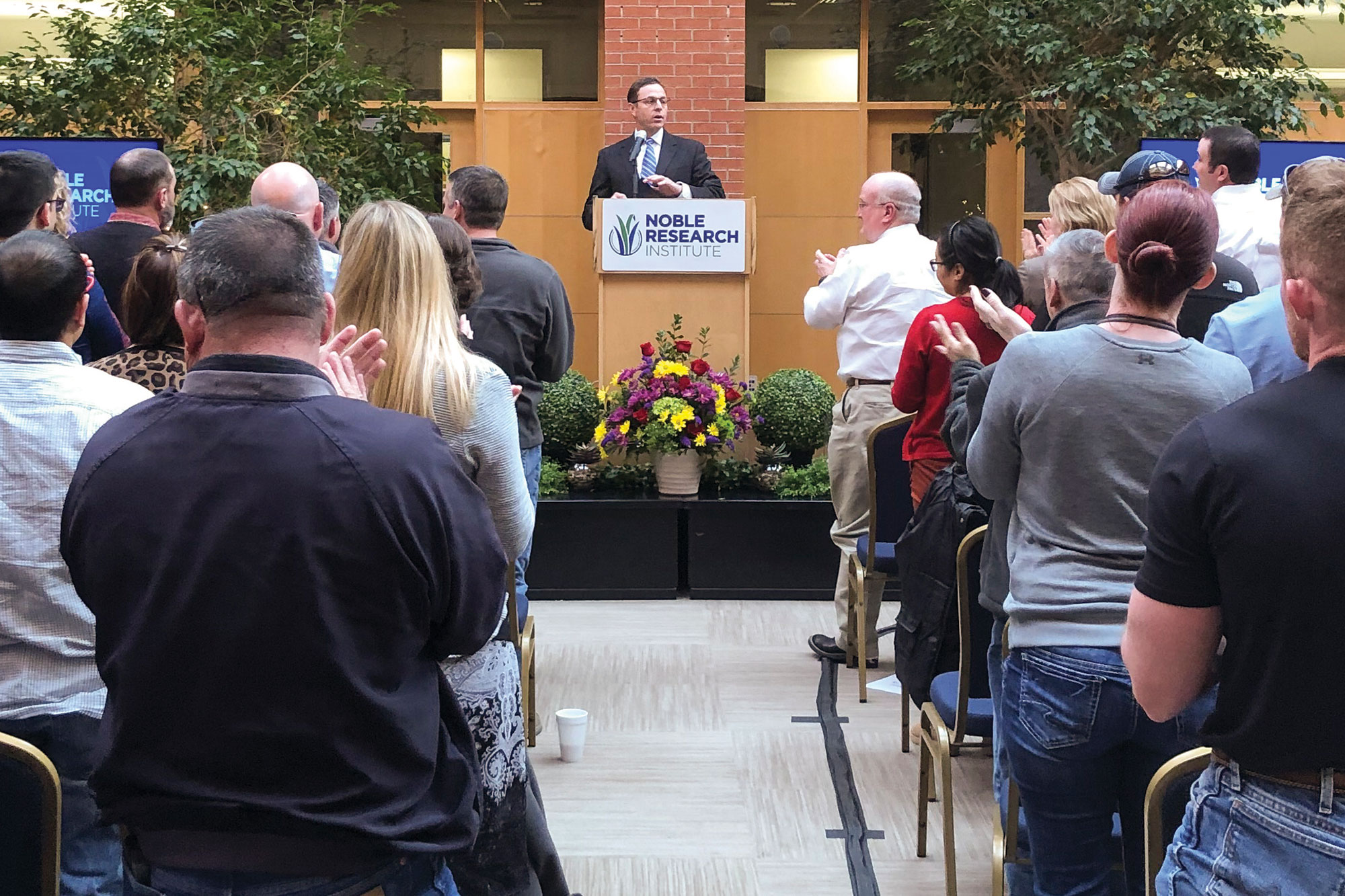
A lifetime of experiences and an intentional journey of self-improvement have coalesced to prepare him for the momentous task now ahead: leading the country’s largest private agricultural research organization.
The brainy boy, who grew to be a thoughtful leader, has started to write his chapter in the storied history of the Noble Research Institute. A sentiment he waves off with a few words and a smile: “It may be a new chapter, but it’s the same book. And I’m not writing it. We’re all writing it together.”
A Servant Leader
The decision to hire Rhines as the ninth president and CEO in the organization’s 74-year history came on a Friday afternoon in January. Noble’s governing body concluded its regularly scheduled meeting with a vote. Six months, a global executive search firm, interviews with national candidates, and careful consideration by all those involved ended with a unanimous chorus of yes votes.
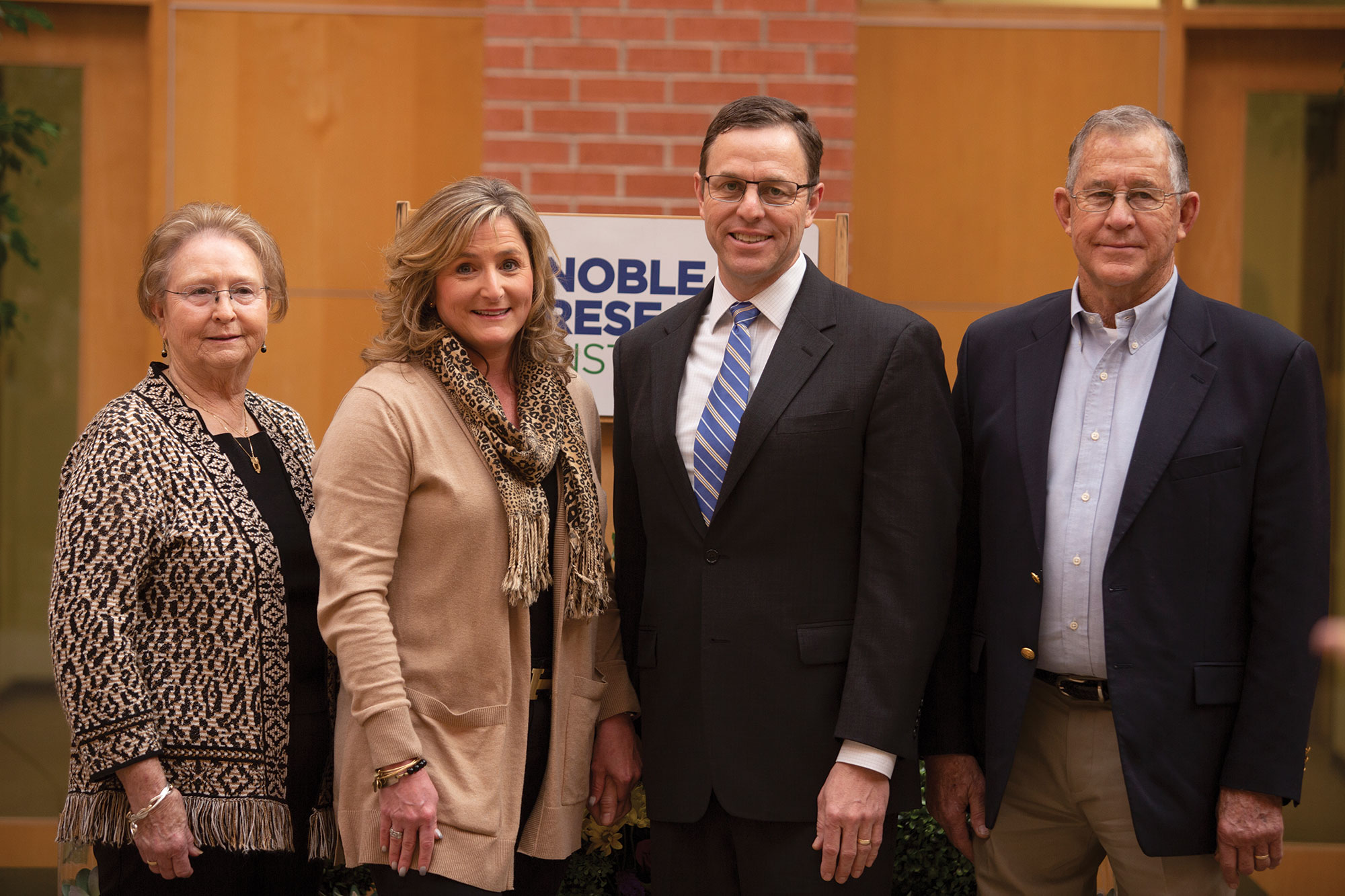
“We wanted someone who possessed three distinct characteristics: a significant understanding of agricultural research, the vision to advance the Noble Research Institute into the next generation, and high personal integrity,” says Rusty Noble, chairman of The Samuel Roberts Noble Foundation Board of Directors (see side note) and grandson of the organization’s founder, Lloyd Noble. “We found all of those qualities in Steve.”
Side note: The Samuel Roberts Noble Foundation is the sole member/manager of Noble Research Institute, a nonprofit single-member limited liability company. The Foundation acts through its board of directors to provide leadership for the Institute to carry out its charitable purposes, act as a good steward of its resources, and conduct and support its activities in accordance with the vision of founder Lloyd Noble.
Since Rhines was an internal candidate and his predecessor Bill Buckner had already retired, there was no need to delay the announcement. On the following Monday, employees gathered in the Atrium, morning sunlight streaming through the panels above. A new day was beginning in more than one way.
Excited chatter filled the massive space as Rusty Noble took to the stage to introduce the new president. When he said, “The individual selected has been working at Noble for almost 20 years and has led many of the organization’s key initiatives,” the audience began to look side to side and smile. Noble continued: “Through this process, this individual has demonstrated the ability to articulate the challenges facing Noble and the potential opportunities before us. This made it clear to us that he was the only candidate to lead this organization. Please join me in congratulating the next president and CEO of the Noble Research Institute, Steve Rhines.”
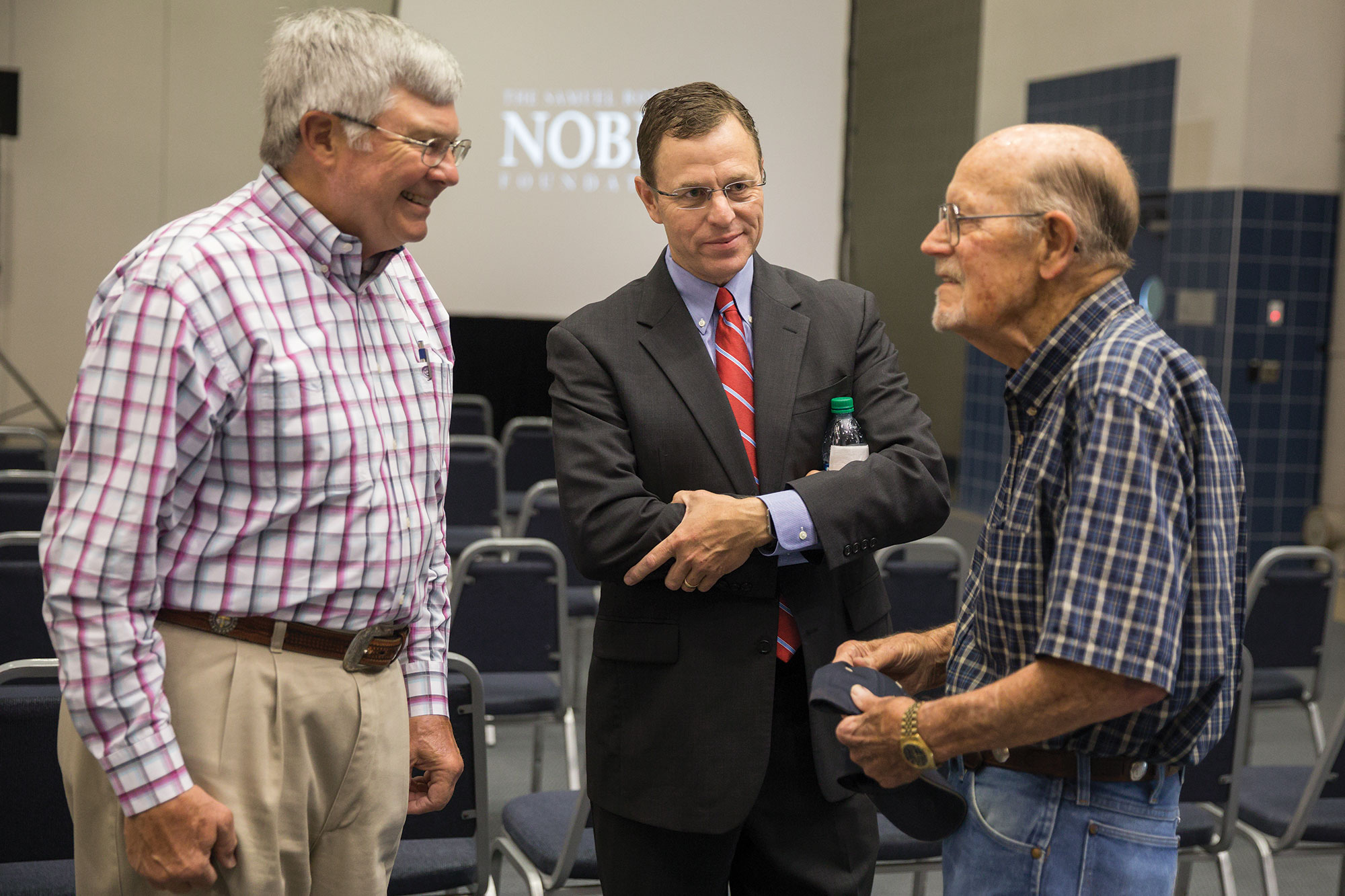
The Atrium erupted with applause and cheering. Rhines took to the stage. His 10-minute speech recapped his journey to Noble and revealed what everyone in the room already knew: He loves Noble. “For the last 18 years, there have been good days and bad days. But I have never lost my passion for this place or my love for what we’re trying to do,” he says. “I see it as more than a job. I see it as a calling. I know all of you feel the same way.”
Rhines called on his employees not to fear change and outlined Noble’s continuing mission to advance land stewardship in beef cattle production with producer profitability. He talked about his personal faith and his desire to be a servant leader for an organization dedicated to serving others. “Today is the first day of my last job,” he pauses, emotion in his voice. “By God’s grace, and as long as the board will have me, I will be here until I retire, working alongside you to fulfill our mission.”
Thunderous applause again swelled and subsided. An impromptu line of well-wishers immediately formed. Rhines shook hands and chatted for a minute with each person, repeating the process again and again. Employees filed out with several voicing their insights. “That’s the right guy at the right time,” one says. “I’ve never been happier,” another adds.
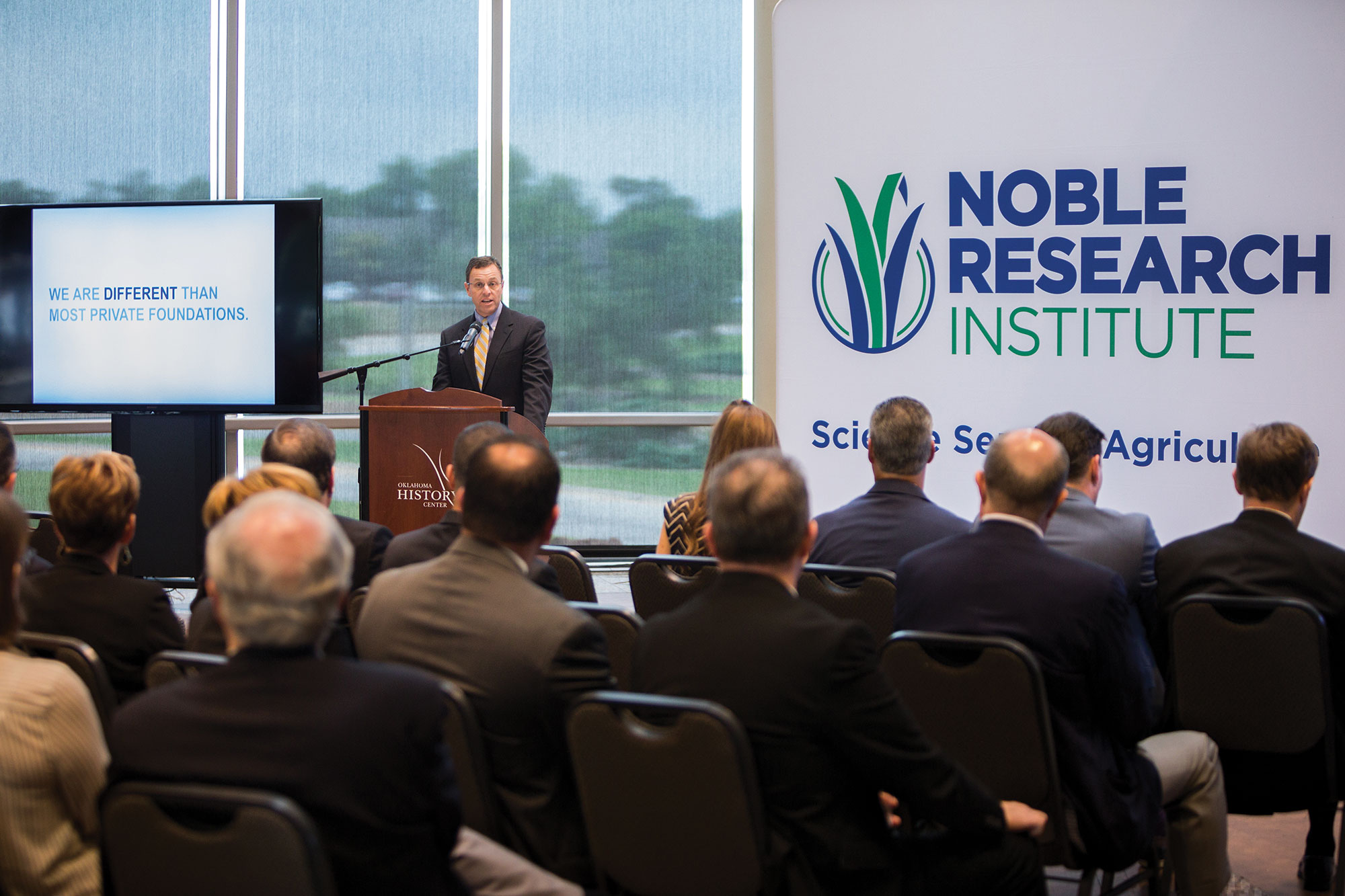
The only missing piece to this perfect morning was his parents, Paul and Phyllis. However, as with most great days, details just seem to work out. Rhines’ wife, Debbie, made a command decision and slipped his folks into the back of the room so they could watch their son take the culminating step in his 30-year career. They unexpectedly emerged from the crowd and embraced their son then stepped back so that he could continue interacting with his employees, beaming wide smiles as only parents can.
As the announcement began to wind down, Rhines turned and says, “It’s a lot to happen to a boy from Antlers, Oklahoma.”
Antlers, Rockets and Ketchup
Antlers is nestled in southeastern Oklahoma and is home to about 2,500 people, a population density that has remained virtually unchanged since the 1930s. The tiny hamlet was Rhines’ home from third grade through high school.
Rhines’ father managed multiple retail stores in southeastern Oklahoma during his son’s formative years. Rhines served as stock boy and janitor a couple hours a day after school in the Antlers stores. He can recall the smell of the stores and even picture the arrangement of stock on the shelves. He also remembers forming an early opinion: “My father was a great salesman and loved it. I figured out pretty quickly that I was not cut out for the retail profession.”
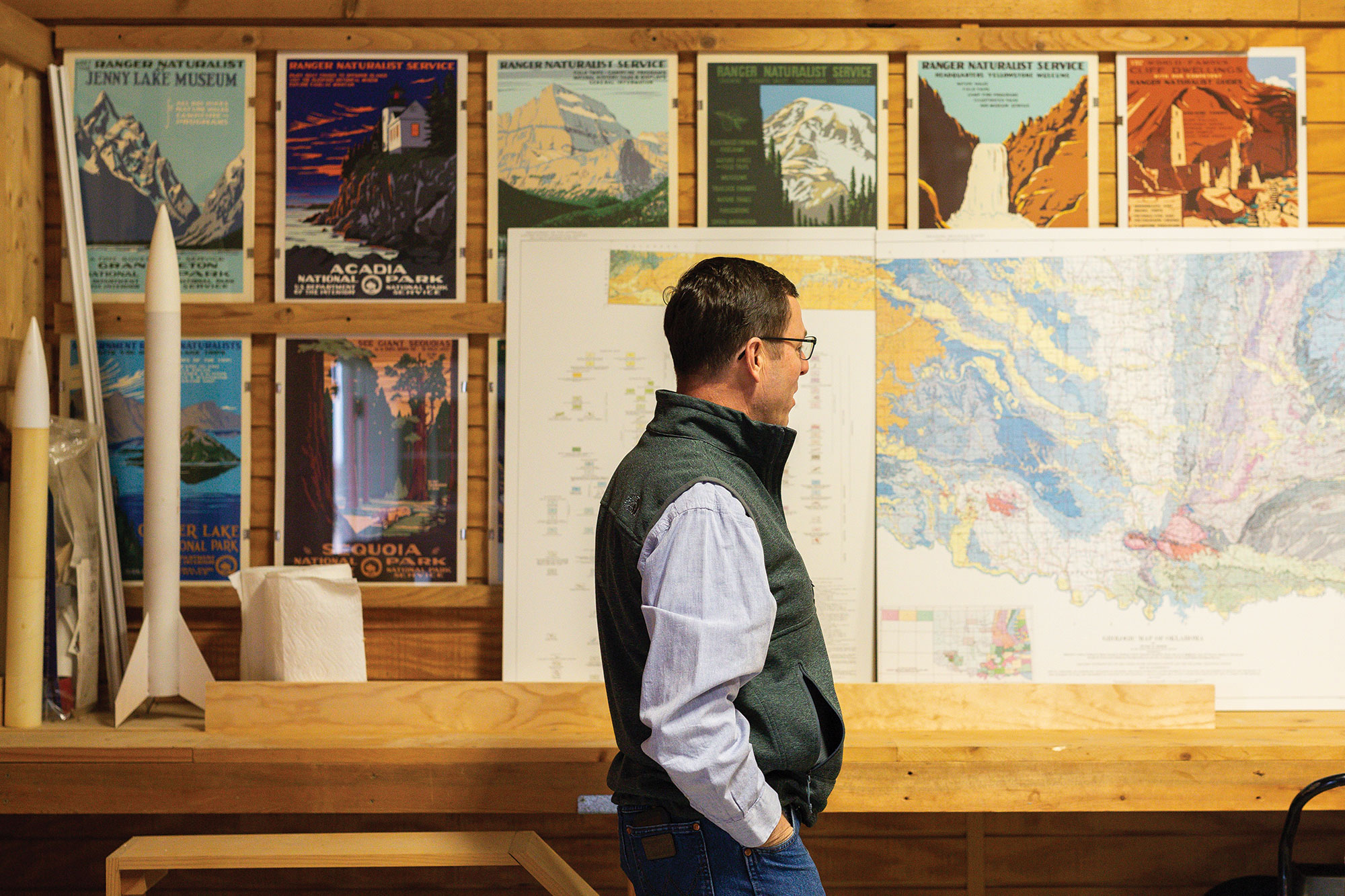
A sales career was clearly a nonstarter, so Rhines cast his eyes up. His parents gave him his first rocket model set in the seventh grade. (To be clear, not spaceships but missiles.) He launched it and, one might say, as it skyrocketed, so did his interest. He was hooked.
Play turned to tinkering. Building turned to designing. In short order, Rhines’ life trajectory was set; he was going to be an aerospace engineer and pilot. Throughout high school, he remained obsessed with all things missiles. During his senior year, he won his local, state and regional science fairs to earn a slot at the International Science and Engineering Fair. His project’s title? “Computer-Assisted Design and Analysis of Exterior Ballistic Projectiles.” In layman’s terms, he developed computer software for designing and assessing a surface-to-surface missile. In high school.
Today is the first day of my last job. By God’s grace, and as long as the board will have me, I will be here until I retire, working alongside you to fulfill our mission.”
Steve Rhines
He was admitted to the University of Oklahoma with a U.S. Air Force ROTC scholarship. Everything was on course to fulfill his blue sky dreams right up until Rhines went to take his physical prior to his freshman year in college. “As it turns out, I was blind as a bat,” Rhines says. “There was no way I could fly a jet. Later in life, I came to realize that I do not have the needed skills or constitution for flying, so everything worked out.”
He doesn’t linger on the memory. He chuckles and moves on. In fact, that’s what he did 30 years ago. While disappointed, Rhines regrouped quickly, looking toward the horizon instead of the past. He was determined to be part of the defense industry even if it wasn’t in the cockpit.
On the advice of an engineering faculty adviser at OU, he shifted from aerospace engineering to mechanical engineering. The class load looked like ingredients for NASA stew: chemistry, fluid and thermal dynamics, and 12 hours of higher mathematics. “I’m not the smartest guy in the room, but I am a worker,” Rhines says. “I studied a lot.”
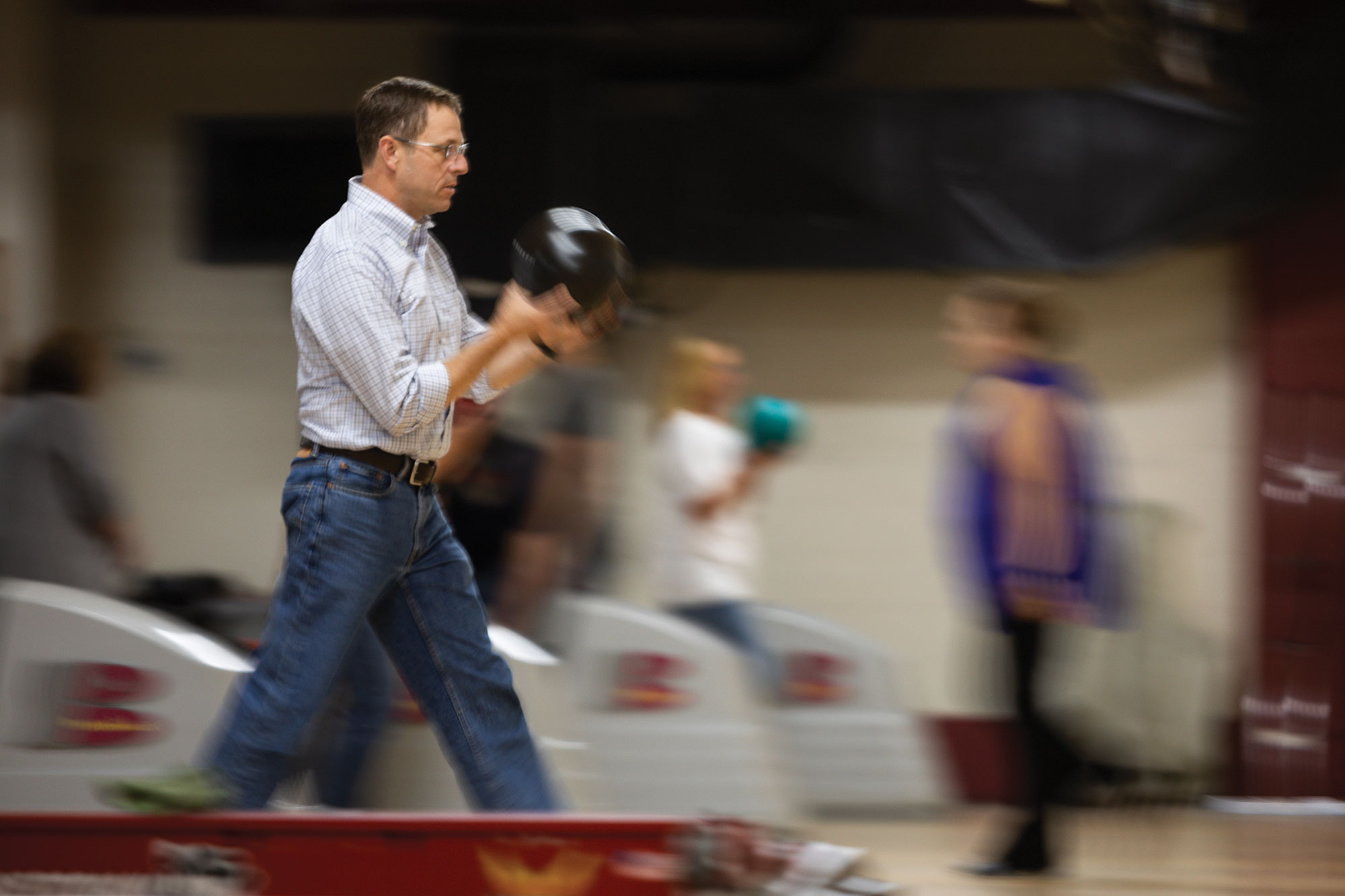
College was not all books and slide rules, however. Just a week before Halloween 1990, Rhines was introduced to Debbie Little, an elementary education major. Debbie’s friend Angela was dating one of Steve’s engineering classmates. The couple was planning a Halloween get-together and dragooned their single friends into joining them. Angela wasn’t playing matchmaker, though. “She told me, ‘You’re not going to like him. You have nothing in common with him, but you’re single and he’s single, so you’re just going to come with us,’” says Debbie with a laugh.
The evening started with dinner at a burger joint, and a dry cleaning bill seemed more likely than love. As Rhines attempted to put ketchup on his fries, he began to bang the bottom of the glass bottle (no plastic squeeze containers in ’80s). In almost sitcom-fashion, a red glob unexpectedly shot out and landed in Debbie’s hair. Everyone laughed, including Debbie.
Dinner turned into game night and, when the other two couples headed off to a haunted house, Rhines and Debbie split off from the group. The engineer-to-be and the teacher-to-be who had “nothing in common” sat in the car in front of her apartment, talking and laughing until the wee hours of the morning. “Steve is so smart, and he’s got this dry wit,” Debbie explains. “It’s part of his charm. I was totally smitten.”
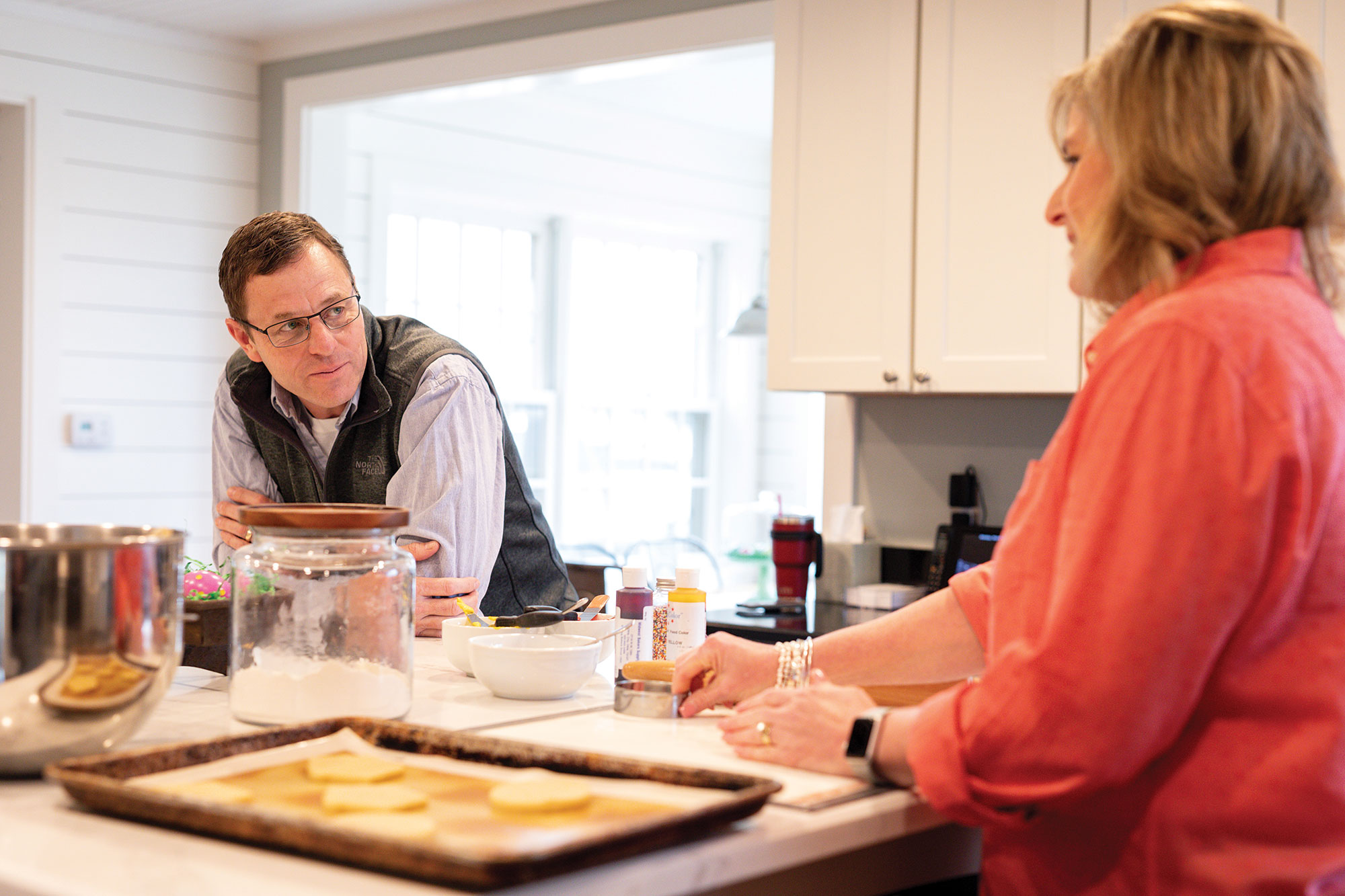
The next morning, Debbie woke up and found dried ketchup in her hair. She laughed again, and they were a couple from then on. Ask Rhines if it was love at first sight and he’ll give you a slight eye roll, but then admits: “Probably something close.”
Rhines graduated a few months later and started working for Texas Instruments, at the time a manufacturer of advanced missile and avionics systems, in early 1991 in Dallas, Texas. He had interned for the defense contractor for three consecutive summers, so the segue into full-time employee was seamless. However, the internships had brought a simple revelation: a career in engineering was not likely his endpoint. “The research and the science were amazing,” Rhines says. “I liked the concept but didn’t like the reality.”
Steve has a gift of seeing things in a bigger picture. He sees how pieces will fit together for a greater purpose. … His vision of greatness becomes contagious.”
Jill Wallace
During his final semester at OU, Rhines had applied to law school. Two of his best, childhood friends had decided to pursue careers in law. It sparked an idea. Rhines could see the connections between engineering and being a patent attorney. The profession provided exposure to emerging technologies, which he enjoyed. It also afforded him the opportunity to assist inventors and companies in fully realizing value in their ideas (something else he loved to do). Patents were legal puzzles to be put together and a perfect fit for a brain already hard wired for finding solutions.
Rhines started law school in the fall of 1991, ending a short engineering career. Another life redirection, but this time, he wasn’t alone.
By summer, Debbie had graduated from OU and moved to Dallas with Angela, her unintentional match-making friend, to teach. Rhines and Debbie were engaged in June, and soon she was offered a position at the prestigious Highland Park School District. Rhines began to survey his future options with earnest.
The couple married in May 1992 after his first year of law school. The wedding was picture perfect (besides some unfortunate eye glasses that his sons still ridicule to this day). The next half of a decade sped by in a blur. Graduation in 1994. Two stops as an in-house counsel before making the jump to the prominent Sidley Austin, LLP in 1997.
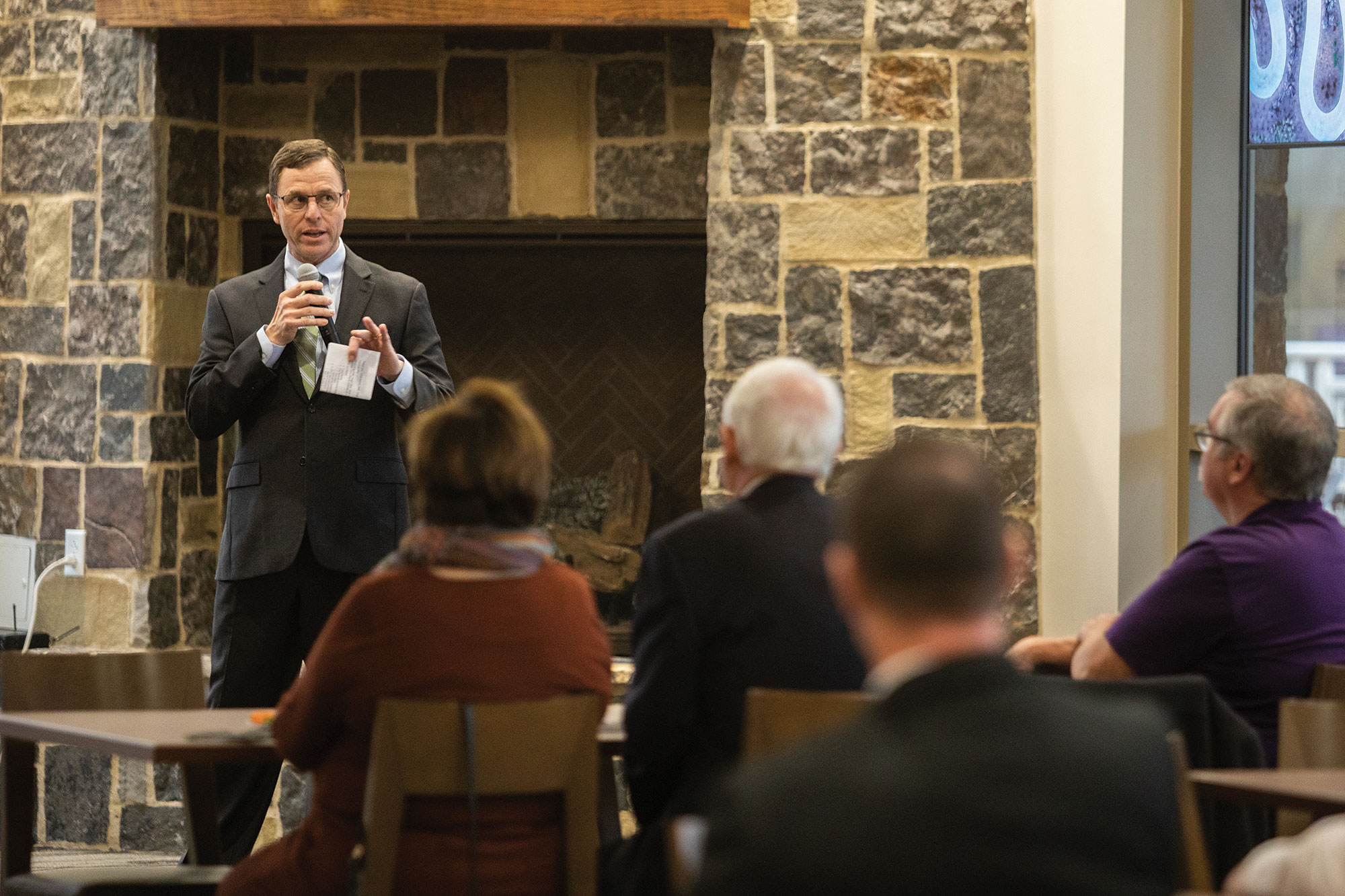
Working in the hyper-competitive law firm culture only served to feed Rhines’ insatiable desire to achieve. His work ethic shifted into a new gear and soon he was cresting 2,400 billable hours a year and writing off countless more to develop clients and mentor junior attorneys.
The breakneck pace was fine when it was just Debbie and him. However the next year, she gave him three reasons to come home early.
Daddy, Mommy and Baby Make 5?
A little less than six months after Rhines earned his downtown-facing office on the 34th-floor of the KPMG Centre Building, Debbie announced they were having a baby. Well, actually, three babies. The couple welcomed triplet boys — Andrew, Thomas and Grant — into the world in the spring of 1999. Suddenly everything was times three. Three cribs. Three diaper changes. Three bottles. Three spit ups. Three more diaper changes. Three of everything.
The serenity of their suburban home had turned into a three-ring circus of activity. Babies were constantly being juggled. There was nonstop motion and noise. And there was always food on the floor.
While most parents begin with a two-on-one advantage, the Rhines were playing zone defense from the beginning. They were outnumbered and outgunned. Even with help from family, it was only a matter of time before a tipping point.
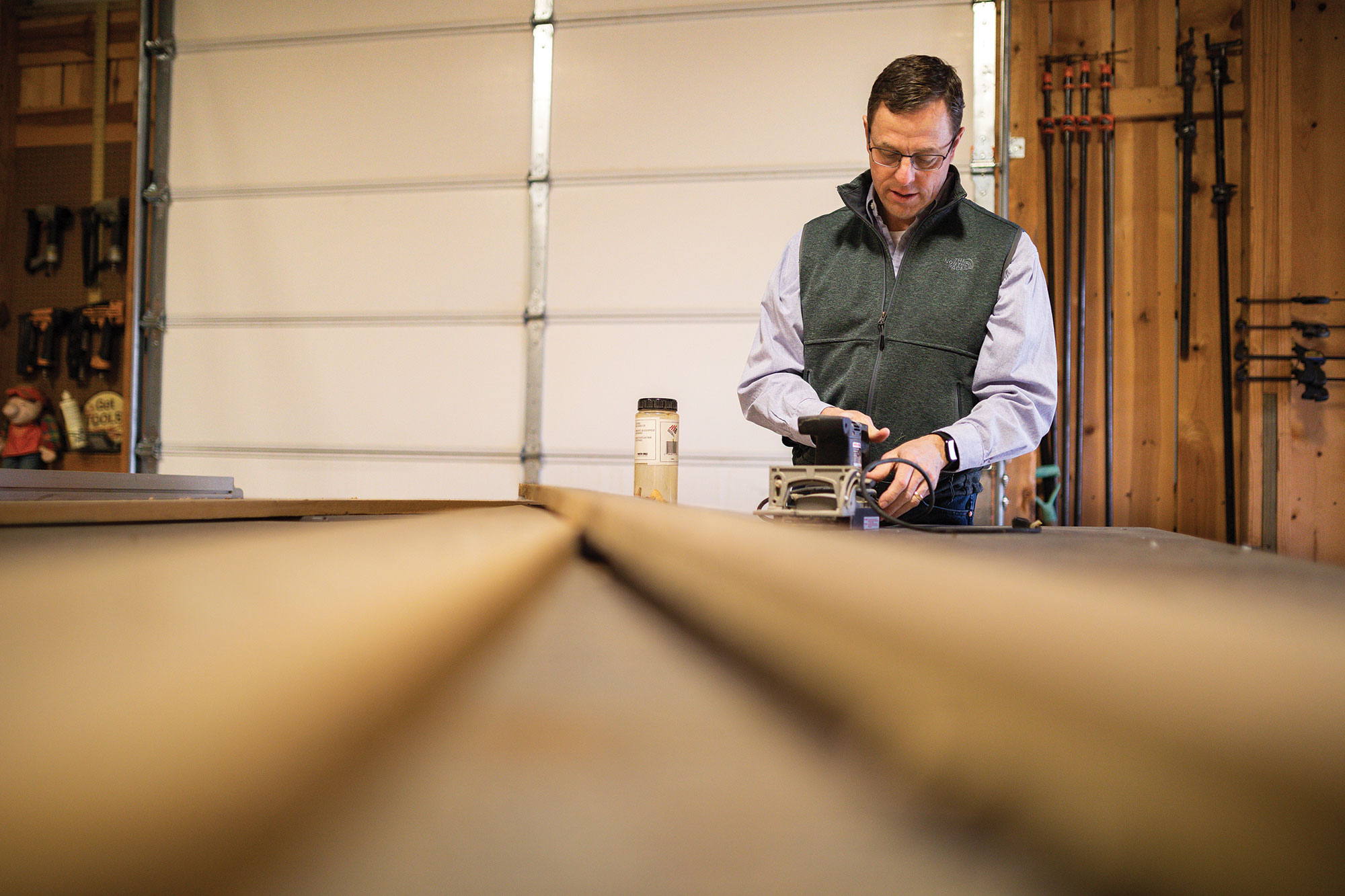
It wasn’t work. Rhines kept pace. The long hours continued. He helped with the boys when he wasn’t in the office, choosing to sacrifice sleep to maintain his work and home responsibilities. “I remember writing patent applications with Grant sleeping in my lap,” Rhines recalls. “You always had a baby in one hand and an eye on the other or the other.”
But the law waits for no one and neither do doctor appointments. Rhines missed (another of) the boys’ checkups due to work, and the dam broke. He returned home and found his wife sitting at the computer. Debbie’s eyes said she was angry. Her words clarified that she was very angry.
“My wife is — by all accounts — the living embodiment of patience,” Rhines says. “But on this day she had decided life was going to change.”
Debbie sat at the computer, looking online for jobs in her hometown of Ardmore, Oklahoma, where most of her extended family still lived. They needed help, and they were moving to where the cavalry was stationed.
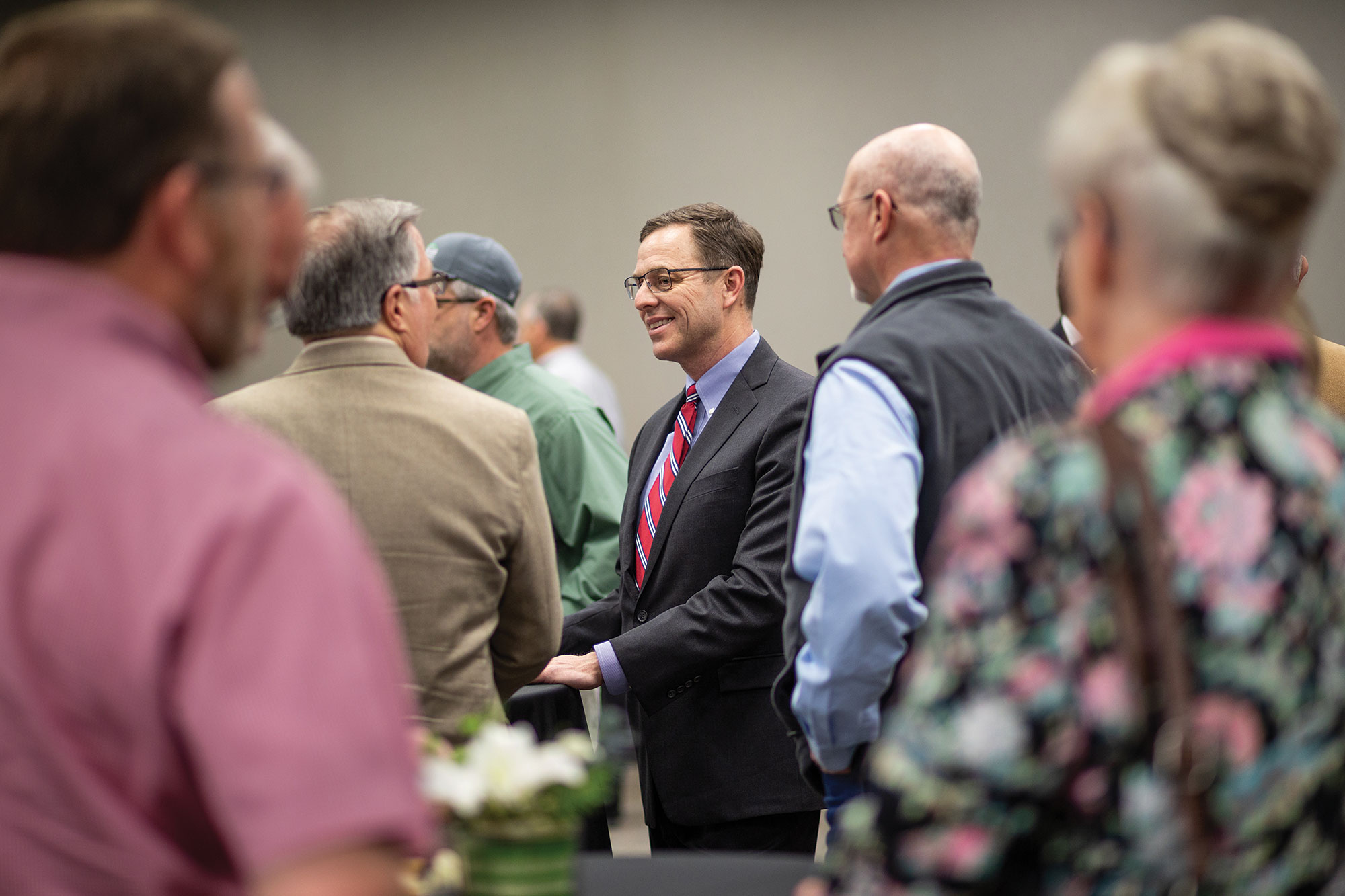
She went to the Noble Research Institute (then the Noble Foundation) website and began pointing at jobs on a list. “Can you do this?” Stunned Rhines just shook his head no. “How about this?” said the exhausted mother. Again no. Then three words appeared on the screen: Technology Transfer Manager. All the emotion was sucked out of the room, and they sat reading the job description. It was perfect. The job looked tailor-made for Rhines. “I didn’t want to be that guy who was never there,” Rhines explains. “We needed a change, and I believe God provided the path.”
While he sought out all the information he could about Noble before the interview, there was no substitute for the experience of visiting campus. During his interview, he heard Noble’s genesis story: Philanthropist Lloyd Noble lived through the Dust Bowl and wanted to secure the land for future generations through education, consultation and research. He immediately fell in love with the mission. “Debbie brought me to the doorstep, but I ran through it,” he says. “I don’t have to tell you, this place is special.”
On March 1, 2001, Rhines walked into Noble as an employee for the first time.
So a Lawyer Walks Into Noble
Rhines went from the Dallas skyline to an office in the center of a research building. The new office was short-lived, and due to facility renovations, he soon found himself in a trailer out back. This trailer — divided down the middle — housed both legal and security. The legal-security trailer shared a wooden deck with a neighboring trailer-laboratory, where a young scientist and her staff sought to improve alfalfa as a forage. It may not have been the trajectory many lawyers would have sought, but it was perfect. Rhines loved the people, the place and the work.
Opportunities to contribute beyond intellectual property management began immediately. Noble had only started receiving government research grants in the year prior to his arrival, so he was enlisted to build a system to manage the incoming grants, helping navigate rules and regulations new to the organization. The next year he was promoted to director of legal affairs.
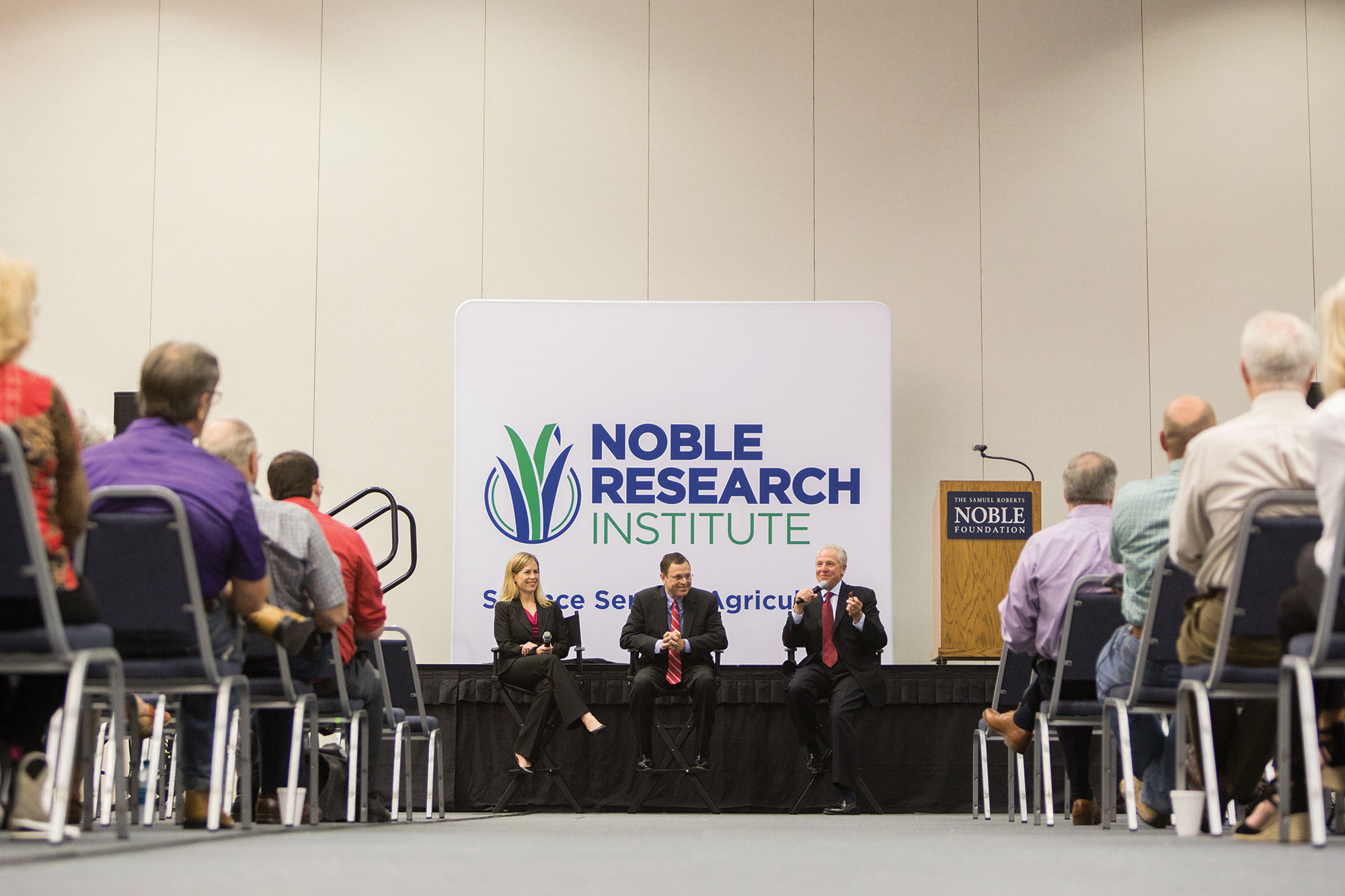
In addition, he contributed to many assignments that had nothing to do with legal work. He helped then-executive-vice-president, and now close friend, Larry Pulliam raise money for an international research project to sequence the genome of a model legume.
It became clear to Rhines’ colleagues that he was far more than just a lawyer.
“Early in his career, Steve had little knowledge of biological sciences or genomics. It was amazing to watch him consume information and be able to immediately apply that information to our work,” Pulliam says. “That’s Steve. He can take in and process huge amounts of information then translate that knowledge into a usable plan that connects across an organization.”
As the organization grew, so did its legal requirements. Rhines dove into technology transfer, policies and contracts, then helped
create a government affairs program in 2005. Rhines was again promoted to vice president, general counsel and director of public affairs.
Over the course of the next 12 years, he’d pick up the communications department, helping guide the organization’s messaging and public relations efforts. He’d also help reshape Noble’s educational offerings and take on one of organization’s most comprehensive projects.
In 2008, Rhines headed the organization’s effort to modify the U.S. tax code to create a new type of 501(c)(3) public charity called agricultural research organizations (AROs). The proposed modification would increase agricultural research capacity in the United States and provide philanthropists another option to invest in public agricultural research. The legislative measure became law in December 2015.
“The development of AROs was almost a seven-year journey, and Steve led the entire effort,” Rusty Noble says. “The project is but one example of his demonstrated vision, critical thinking and tenacity.”

Rhines then saw an opportunity to transform youth agricultural education, not only at Noble, but around the region. The mechanical-engineer-turned-patent-attorney sketched out the plan for creating Noble Academy, a STEM-based youth education program that teaches students about the value of agriculture to their lives. A few years later, Rhines assumed leadership of Noble’s entire educational effort, outlining a system to transform the institution’s producer education effort into a competency-based program. The new system is designed to build producer skills from beginner to mastery over time and through engagement with the Institute’s subject matter experts.
“Steve has a gift of seeing things in a bigger picture. He sees how pieces will fit together for a greater purpose,” says Jill Wallace, CFO and friend of more than 15 years. “He doesn’t stop at good; he strives to make things great, and his vision of greatness becomes contagious.”
As every leader moves, they leave a wake like a boat cutting through the water. Every employee works in the wake of leadership, so I am determined to be purposeful in what I do. At the end of the day, every decision is intended to make Noble better, to give our employees a reason to be proud of the work we do, and to serve this nation’s beef cattle producers.”
Steve Rhines
In addition to the professional growth, Rhines had been on an intentional journey of perpetual leadership development. Several years ago, he and Wallace began challenging each other to become better leaders. They trade books and articles on leadership. They listen to podcasts. They hold each other accountable.
“We have a responsibility to those we lead and to the organization to constantly improve,” Rhines says. “It is important to be constantly striving to grow. It is what we require of our employees, and it is what I require of myself.”
He rooted himself in his faith and focused on living out the principles he had learned. “Steve’s leadership fosters the development of his employees both personally and professionally,” says Brenna Gaik, adult education associate. “He humbly approaches his position of leadership and continually invests in others.”
In the fall of 2018, Bill Buckner, who had served as Noble president for seven years, announced his retirement. Rhines realized that all the work was leading to this moment. He gave voice to his vision. He interviewed. And ultimately he was selected. Reflecting on the entire journey, he says: “It was not always clear where I would end up, but now I believe this is where I was meant to be.”
In the Wake of Leadership
For the better part of 18 years, Rhines had been the man behind the man.
When he came to Noble, he served under Mike Cawley, a sincere and steadfast leader with a fatherly touch and a baritone voice. The stalwart of Noble’s chapter of growth, Cawley guided the organization for 22 years. He’s now a mentor and friend.
For the past seven years, Rhines’ predecessor, Buckner, challenged Noble to undertake large-scale, national projects.
Rhines hopes to embody the best qualities he’s observed in the leaders around him and beyond: Cawley’s genuineness and mentoring, Buckner’s vision for impact, his father’s work ethic and character, and — from his faith — Christ’s love for others. All the while, he is mindful of how his actions affect those he leads.
“As every leader moves, they leave a wake like a boat cutting through the water,” Rhines says. “Every employee works in the wake of leadership, so I am determined to be purposeful in what I do. At the end of the day, every decision is intended to make Noble better, to give our employees a reason to be proud of the work we do, and to serve this nation’s beef cattle producers.”
Q&A
What makes Noble so special?
Our direct connection to farmers, ranchers and landowners. As an agriculture-focused research institute, it is important that we understand their challenges and problems and that we aren’t developing “any” solutions but real solutions that national producers can adopt and implement. That said, we have a clear purpose, a great history, and operations extending from the laboratory to the ranch to answer these challenges. That is all pretty special.
What is your leadership philosophy?
I believe that intentionality and discipline is the recipe for success. Begin with the end in mind; plan where you want to go and what outcome you are seeking. Align your resources to reach that destination and achieve that outcome. Once you’ve laid your course, be disciplined to follow it. If things change or your destination was wrong, have the courage to reassess and move forward.
Our focus is “land stewardship in beef cattle production with producer profitability.” Is that too narrow?
No. For us it is a national focus. We seek to impact more than 650 million acres of ranch and pasture in the U.S. — this is essentially 33 percent of our nation’s land. The primary occupants of these acres are cattle. We believe that caring for and stewarding the land encompasses managing the complex interactions of the soil, water, plants and animals. While most agriculture organizations and subsequent research funding focuses on cropland, we will assist this nation’s farmers, ranchers and landowners in enhancing our nation’s ranch and pasture lands.
What do you mean by “producer profitability”?
This is a practical reality of agriculture or any profession — ranchers need to make a living. There are not many of us who can stay in a profession that consistently costs us more than it makes. We seek to support land stewardship and at the same time preserve “producer profitability.” If a rancher cannot make enough to maintain his or her operation, then somebody else is controlling the outcomes of the land. Further, it is not enough just to get by. If a producer is barely making ends meet, they are often sacrificing long-term land stewardship practices for short-term returns. In addition, producer profitability allows us to look at other enterprises that complement and add to beef cattle production, including pecan production, wildlife management and other similar enterprises.
Is Noble going to do this alone?
Oh no, far from it. While we have some unique resources and talented experts, we can’t go it alone. We will continue to partner with like-minded industry, universities, nonprofits and foundations, and government agencies. We have recently joined a collaboration with the Choctaw Nation, so we now add “sovereign nations” to our list of collaborators. The sector needs all of us to be successful.
Are there any other goals for Noble?
Maintain a workplace that gives each employee pride in what they do to further the whole organization and its purpose. Simon Sinek says: “Give people a reason to come to work, not just a place to go to work.” When we achieve that, much of the downstream impacts to farmers, ranchers, landowners and land stewardship will be taken care of.
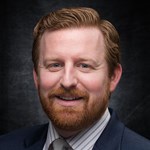
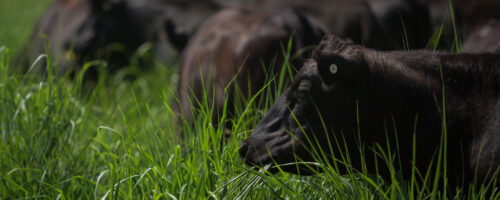

Comment